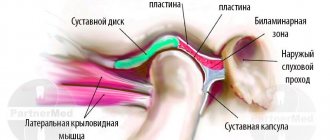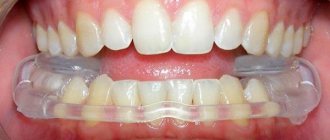Characteristics of the disease
In medicine, the disease is called arthritis of the temporomandibular joint (TMJ). With the help of this joint all movements of the lower jaw occur.
The inflammatory process can occur in acute or chronic form. The main sign of the development of pathology is restriction in the movement of the lower jaw.
Such a pathology requires complex treatment and intervention by specialists of various profiles.
Depending on the area of localization, there are several forms of arthritis:
- disease of the lower or upper joint;
- arthrosis of the upper jaw joint.
Osteoarthritis occurs when a joint is severely deformed. The lesion affects both areas of the jaw node, the cartilage tissue is destroyed. In the first stages, the joint capsule becomes inflamed, then the cartilage tissue is affected.
Traumatic inflammation
The first thing that is required is to ensure the immobility of the affected joint. This should be done by a professional traumatologist. The patient's jaw is fixed with a sling-shaped bandage equipped with a special plate that prevents the jaws from closing. This allows the victim to eat food, even if only in liquid form. Cold compresses are recommended to prevent swelling; At the same time, the doctor will prescribe medications that prevent the development and spread of inflammatory processes. In most cases, systemic administration of painkillers is also required, since injuries are associated with a gross violation of tissue integrity, which can lead to painful shock.
After the swelling subsides, physical therapy will be added to the medicinal treatment methods, designed to prevent the affected joint from fusing into a fixed conglomerate. Physiotherapy is also used: UHF, electrophoresis, diadynamic therapy, phonophoresis with hydrocortisone.
Risk factors
Main reasons:
- Injury. The cause in this case may be a bruise, a blow, or a sudden opening of the mouth.
- Infection of ENT organs. Arthritis of the maxillary joint can be caused by streptococci, chlamydia or tuberculosis.
- Osteomyelitis.
- Untreated caries.
- Periodontal diseases.
- Otitis.
In addition, the following conditions may also affect the development of jaw arthritis:
- Gout.
- Systemic lupus erythematosus.
- Diabetes.
- Thyroid diseases.
- Rheumatoid and reactive arthritis.
Sometimes inflammation can be caused by general hypothermia of the body.
So, due to education, they distinguish:
- infectious arthritis of the TMJ - is caused by infections and bacteria entering the bloodstream, which stimulate the inflammatory process of the joint. In turn, an infectious disease may be of a rheumatological nature or be a consequence of the presence or transmission of diseases such as tuberculosis, syphilis, gonorrhea, etc.;
- dystrophic arthritis of the TMJ - develops as a result of constant heavy physical labor;
- traumatic arthritis of the TMJ - is a consequence of a severe bruise or injury.
How does the disease manifest itself?
- pain in the jaw area, radiating to other parts of the face and intensifying when opening the mouth;
- restrictions in joint movement;
- dizziness, chills;
- general weakness;
- increased body temperature (may be over 38 degrees);
- sleep problems;
- jaw clicks;
- joint pain on palpation;
- deformation of the oval of the face due to the fact that the chin begins to move to the side;
- hearing problems.
The important thing is that with arthritis of the jaw joint, purulent inflammation can begin! In such a situation, the joint turns red, swells and becomes very sensitive. A compaction is felt in the area of the mandibular joint. The skin changes its color, speech is impaired, and the process of chewing food becomes difficult.
Possible complications
If you ignore the symptoms of inflammation of the jaw joint and do not start treatment on time (or replace it with amateur actions), then there is a risk of developing severe complications.
If arthritis of the jaw is of infectious origin, the inflammation will not go away on its own . The pus that accumulates during the process can lead to the “melting” of the components of the joint - cartilage, capsule, ligaments. As a result, things can reach the point of complete immobilization of the joint.
With hematogenous and contact spread of microorganisms, a patient with jaw arthritis may develop meningitis . This is a very dangerous disease, manifested by severe headaches with a rise in body temperature to dangerous levels (400C and above), fainting and photophobia. Failure to take urgent and professional measures leads to the death of a person.
Phlegmon of the temporal region. This is the name for inflammation accompanied by pus formation. It occurs in soft tissues and requires immediate surgical intervention. The root cause of phlegmon may well be jaw arthritis, but without additional circumstances it alone does not lead to the disease. The development of phlegmon also requires a persistent, long-term weakening of the immune system, which is often found in older people.
Inflammation of the jaw joint, left without proper treatment, can also lead to sepsis - penetration of pyogenic bacteria into the circulatory system . Through it they are transported to all points of the human body. The consequence is a massive inflammatory process, manifested by weakness, pathologically excessive sweating, increased breathing and heart rate, and loss of consciousness. The most terrible outcome of the disease is septic shock, which in 50% of cases ends in the death of the patient.
Don't forget about ankylosis. Adhesions filling the articular cavity make the joint immobile; with a bilateral lesion, this results in the inability to open the mouth slightly; with a unilateral lesion, this results in a distortion of the face. The patient most likely will not die from hunger; surgeons and rheumatologists will be able to restore at least partial jaw mobility to the patient. But the treatment will be very long, painful and expensive. And the patient’s quality of life will become very low until the end of at least the first stage of treatment.
And finally, relapses. An incorrectly selected course of treatment, non-compliance with medical prescriptions, or insufficiently long therapy can relieve or smooth out symptoms. But the inflammatory focus remains, and inflammation of the jaw joint will soon begin with renewed vigor.
Diseases of any joints require early treatment. And its course should be prescribed by a professional who is able to correctly determine the cause of the disease, take into account its severity and the characteristics of the patient’s physiology (age, presence of concomitant diseases, resistance of the immune system, and much more).
Type of pathology
The clinical picture of arthritis depends on the form in which the disease occurs:
Acute form.
It is expressed by swelling of the soft tissues and severe pain in the affected area. As a rule, the acute form is the result of some kind of injury.
Chronic form.
This form is manifested by aching pain and difficulty opening the jaw, especially in the morning.
Infectious form.
Most often it is a consequence of a previous illness (flu, ARVI). Infectious arthritis is characterized by severe pain that makes it difficult to open the mouth. The pain radiates to the ears, temples and back of the head.
Traumatic appearance.
The most common form of the disease that occurs against the background of trauma.
Specific arthritis.
Rare disease. As a rule, it occurs as a consequence of syphilis, tuberculosis or gonorrhea.
Purulent form.
It is a consequence of acute arthritis in an advanced form. A compaction forms in the area of the mandibular joint, and body temperature may increase.
Rheumatoid form.
Constant pain in the maxillary joint area. With this form, the clinical picture may be supplemented by pain in the knee, hip or elbow joint.
Depending on what caused the inflammation, the following routes of infection are distinguished:
- Hematogenous. Bacteria enter the joint along with the blood (syphilis, tuberculosis, measles, etc.).
- Contact path. The disease develops due to damage to areas located near the maxillary joint (otitis, phlegmon, abscess).
- Straight way. Develops due to direct penetration (wound, jaw fracture).
The form of pathology can be identified only after examination and diagnostic testing.
Prevention
Preventive measures require timely treatment:
- dental pathologies;
- chronic, autoimmune and endocrine diseases;
- foci of infection.
Try to avoid facial injuries, jaw bruises, hypothermia, which can provoke inflammatory processes. Eat rationally and lead a healthy lifestyle.
What will happen if left untreated?
The consequences of ignoring or insufficiently serious approach to treatment can lead to severe consequences, depending on its type. The serous period of acute arthritis can turn into a purulent one. The inflammatory process can spread to other organs and systems, which can lead to sepsis, meningitis, and phlegmon. Untreated acute and traumatic arthritis of the jaw turns into a chronic form of the disease.
Chronic arthritis causes the appearance of adhesions in the joint, which eventually leads to ankylosis, in which the joint is completely immobile or contracture, while mobility is only partially preserved. Untimely treatment of rheumatoid arthritis of the TMJ leads to damage to other joints and internal organs: kidneys, lungs, heart. The prognosis for this is the most unfavorable.
Arthritis of the maxillofacial joint is a serious, rapidly progressive disease. Remember, the earlier treatment is started, the more effective it is.
Learn about effective exercises to relieve tension and reduce pain in this video:
Diagnosis of TMJ arthritis
Taking into account the etiology of the disease and based on the main reason for its occurrence, in order to establish the most accurate diagnosis necessary for selecting high-quality and qualified treatment, the leading specialist can prescribe a consultation and examination by doctors of narrow specialization in the field of dentistry, traumatology, rheumatology, otolaryngology, dermatology, phthisiology and Infectiology.
The main way to diagnose the disease is x-ray examination. Currently, in modern medicine, in order to avoid excessive radiation exposure, patients are prescribed computed tomography. If, based on X-rays or other imaging tests, it is determined that the patient has widening of the joint space, then he is diagnosed with acute arthritis of the TMJ, and narrowing of the joint space indicates the chronic nature of the disease.
If the patient has acute arthritis, then it must be differentiated from diseases such as:
- Triple neuralgia;
- acute otitis;
- pericoronitis.
Manifestation of jaw arthritis
In this case, the disease causes a feeling of pressure on the jaw joint or both joints. Later it becomes impossible to fully open the mouth. As the disease further develops, the patient's body temperature can rise to 39 degrees. Often at this stage even intoxication occurs.
The affected joint or both joints become very painful and swollen. The mucous membrane around the joints becomes inflamed. Then the pain intensifies and begins to radiate to the ears and temples. Bursts of pain are felt even when walking or tilting the head.











